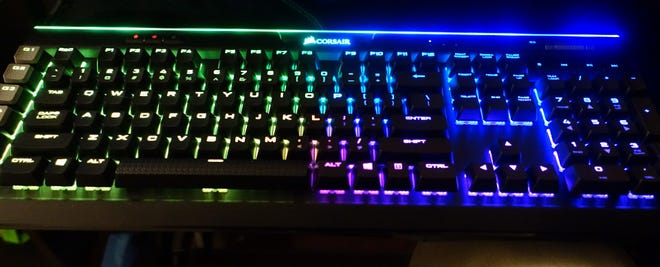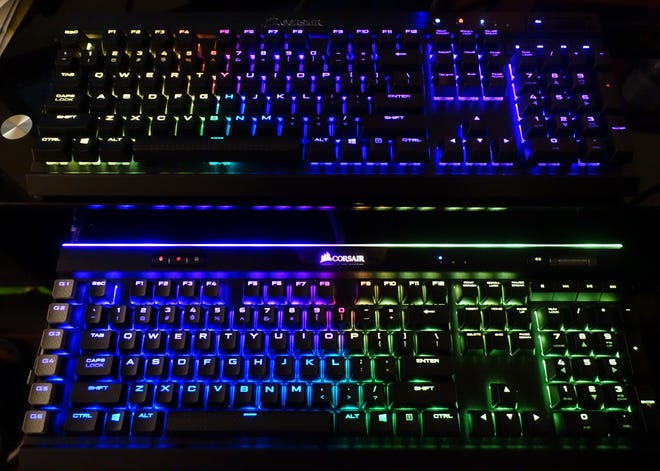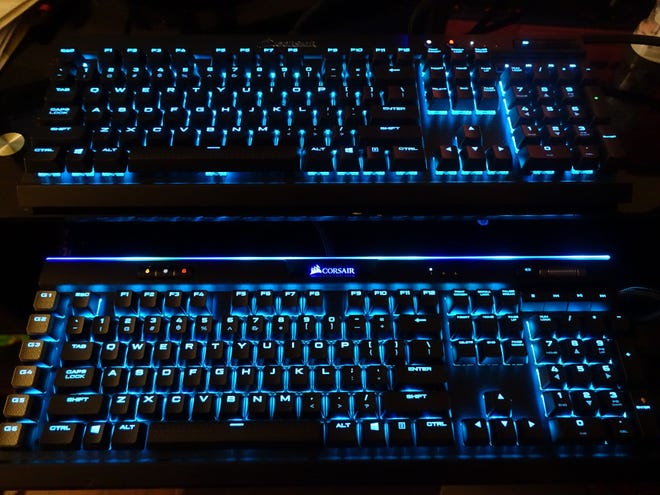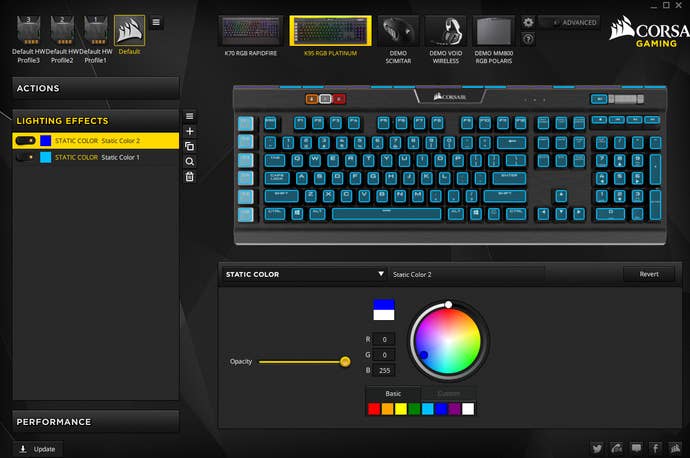Corsair K95 Platinum Review: The Flagship Learns From Corsair's Solid Mid-Range
Corsair introduces a new flagship mechanical keyboard. Who is this monster made for?
This article first appeared on USgamer, a partner publication of VG247. Some content, such as this article, has been migrated to VG247 for posterity after USgamer's closure - but it has not been edited or further vetted by the VG247 team.
When I purchased my first mechanical keyboard a few years ago after extensive research, I ultimately went with a Corsair K70. The keyboard screamed premium every time I saw one in the wild: that strong aluminum construction for the base, the unique raised-key design, and the malleable lighting engine added up to a great keyboard. I eventually switched to a Logitech G810, because it's a quieter keyboard and I love the people in my life, but the Corsair line of keyboards are still winners.

The K95 Platinum represents a new flagship for Corsair keyboards. It's the new base for the K95 line, sitting above the host of mid-range K70 keyboards used today by many gamers. This is the big kahuna, the keyboard for those who game on a regular basis and are willing to pay to the $199.99 asking price for a premium bit of hardware.
So let's look at what you get for the price tag.
Removing the K95 from its packaging, it looks like an upgraded version of the K70 Rapidfire. The classic aluminum construction and raised mechnical key design is still here. You have the same options for Cherry MX switches as the K70 line: Red, Brown, and the new Speed switches that debuted in the Rapidfire. The key caps have the new wider font that started in the Lux line of K70 keyboards, allowing the RGB lighting to show through even better. The USB 2.0 passthrough remains on the back of the keyboard and the dual USB cable is still the same heavy braided cloth version found in earlier Corsair keyboards.



Side-by-side with a K70 Rapidfire though, the differences become clear. It stands between the K70 Rapidfire and older K95 in size. At 465mm x 171mm x 36mm, it's not a wide as the K95 due to only having a single row of six programmable G-keys, as opposed to the three rows in the older keyboard. That same row of G-keys accounts for the extra width compared to the K70 Rapidfire. Weight is the same story, at 2.88 lbs, it's lighter than the old K95, but slightly heavier than the K70 Rapidfire.
The additional keys have also moved around a bit. The Windows key lock, lighting switch, and the new profile key have moved to the right side of the keyboard. The media keys remain in the same spot, but have a new raised design, instead of the more recessed versions found in previous Corsair mechanical keyboards.


There's a few smaller extras as well. Instead of the flat bottom of previous Corsair keyboards, the bottom of the K95 Platinum has grooves to tuck in USB headset cables and keep them out of your way. The keyboard still comes with a keycap puller and a set of contoured keys for FPS (W,A,S,D) and MOBA (Q,W,E,R,D,F) play.
Hardcore keyboard aficionados may have issue with the K95 Platinum's high price tag because the rather thin ABS plastic keycaps, instead of more premium doubleshot PBT keycaps. The latter would be more durable, and highly resistant to wear, ultraviolet light, heat, and friction. That's not a personal problem on my end, but I've seen other keyboard heads complain about the omission in older Corsair keyboards. (Really, any mechanical keyboard from a major manufacturer.)



There's also a new wrist rest, which has a detachable, magnetized soft-touch insert: one side is smooth, while the other is contoured. It's a good addition if you use wrist rests - I don't - but the rest itself seems to act as a magnet for keyboard dirt and grime.
The biggest new feature in the K95's design is the LightEdge. There's a 19-zone LED bar stretching over the top of the keyboard (and through the Corsair logo). Like the rest of the keys on the K95 RGB Platinum, the LightEdge bar is fully customizable: you can set different colors and lighting effects for each zone on the bar, like the purple, red, and blue mix I threw together for my demo pictures. Overall, it's not necessarily a useful feature, but it gives the new K95 a bit of pizazz and pop.




Internally, the K95 Platinum still has the onboard storage feature of the old K95. On the previous model, you could store your macros and lighting configuration on the keyboard's onboard memory, letting you take everything anywhere. It was a useful feature for professional gamers, those who had frequent LAN parties, or anyone who gamed on multiple PCs.
With the Platinum, that feature has been expanded. The K95 Platinum has 8MB of profile storage and an ARM Cortex processor, meaning you can now store up to three different profiles on the keyboard. That previously-mentioned Profile key allows you to switch between all three profiles at the press of a button, though without different lighting there's no way to tell which profile you're in. Again, this is a pro-level addition. The profile key itself is useful for everyone, letting you switch lighting profiles without going into the software, but the onboard storage is still a feature for a hardcore level of player.
What you have here is a melding of the K70 Rapidfire and the older K95 line. The best of the lower range of keyboards has been put into Corsair's high-end line. The Cherry MX Speed switches are still goddamn responsive: a low 1.2mm actuation point and 45g key activation means these switches will move as fast as you do. I'd probably still go with Brown switches if I was buying this keyboard on my own, but the Speed switches remain a marvel. I've been using the keyboard day-to-day for just under a week. In typing, the Speed switches still take a while to get used to, with frequent errors on my part from brushing over certain extra keys. In gaming though, they shine brightly, always ready for any twitch movement in my Overwatch play.
All of the lighting and macro configurations are handled in the Corsair Utility Engine. The software is easy to get into, but in the past, the difficulty of setting up the lighting engine has made it hard for me to really dive in and make changes. It works in a layer system, with different layers of lighting colors and effects working together to create a single unified design. For simple effects and solid color options it's fine, but for complex lighting, the CUE software is still for enthusiast players only. It's still a bit obtuse for a casual player, but very malleable if you have the time. Macro configurations are much easier, just requiring you to choose a key, record your actions, and then save the macro.


The K95 Platinum is Corsair's Aston Martin in design and price tag. It has everything that a pro-level gamer would need and there are few other keyboards that match the brilliant lighting and aluminum build found here. If you're a rather casual gamer though, it's hard for me to recommend this to you. If you're a user of the old K95, it's really time to upgrade. If you have a newer K70, it's all about if you're willing to swallow the additional cost for the line of programmable keys, onboard storage, and the LightEdge. The Corsair K95 RGB Platinum is top-of-the-line, but not everyone can play at that level.

